Your mobile device captures stunning sunset photos thanks to advanced camera technology and intelligent software optimization. Multiple lenses, high-resolution sensors, and AI algorithms work together to enhance your shots. HDR technology balances bright skies with darker foregrounds, while improved night mode excels in twilight scenes. The camera's AI recognizes sunset conditions, adjusting settings in real-time to capture vivid colors and rich details. Golden hour lighting effects are maximized, creating dreamy, warm-toned images with enhanced textures. With these features, you can easily snap professional-quality sunset photos on-the-go. Discover how your smartphone's camera transforms fleeting moments into breathtaking memories.
Smartphone Camera Technology Advancements
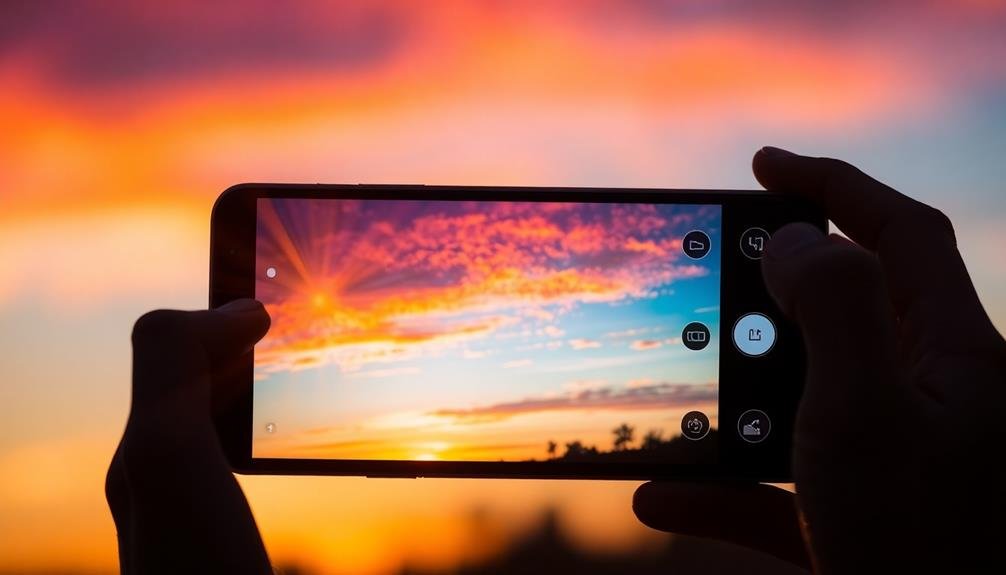
Smartphones have revolutionized the way we capture sunsets. The rapid advancements in mobile camera technology have transformed your phone into a powerful tool for capturing breathtaking sunset images.
Modern smartphones now feature multiple lenses, each optimized for different shooting scenarios. Wide-angle lenses allow you to capture expansive sunset vistas, while telephoto lenses let you zoom in on distant details without losing quality.
High-resolution sensors, often boasting 40+ megapixels, guarantee your sunset photos are crisp and detailed. These sensors excel in low-light conditions, essential for capturing the subtle hues of dusk.
Advanced image processing algorithms, powered by AI, automatically adjust settings like exposure, white balance, and contrast to enhance your sunset shots.
HDR (High Dynamic Range) technology has become a game-changer for sunset photography. It combines multiple exposures to capture both bright skies and darker foregrounds in a single image.
Night mode capabilities have also improved dramatically, allowing you to capture stunning twilight scenes long after the sun has dipped below the horizon.
Golden Hour Lighting Effects
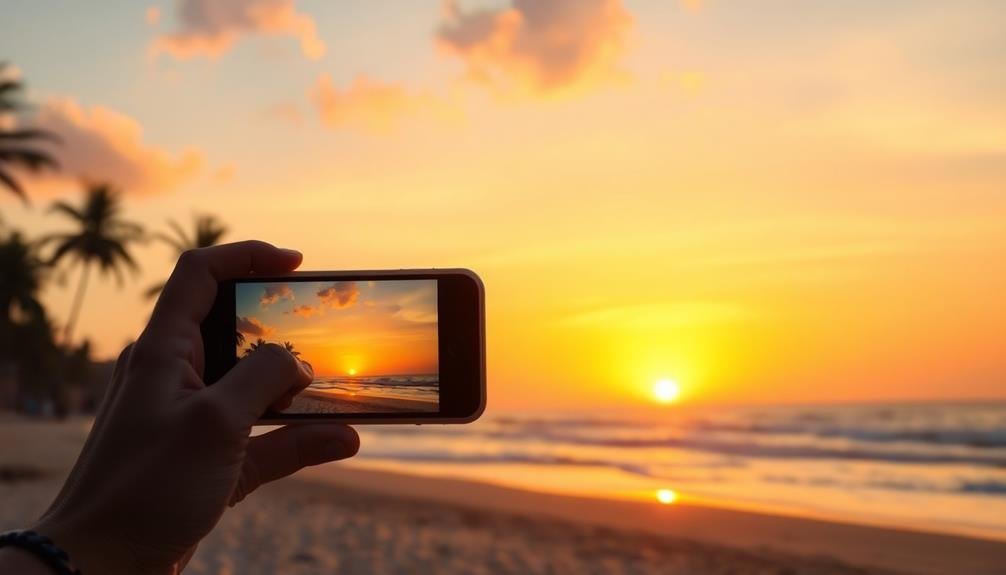
Why is the golden hour so revered by photographers? It's the magical time just after sunrise or before sunset when the sun's low position creates a soft, warm light that bathes everything in a golden glow. This unique lighting condition enhances your mobile device's ability to capture stunning sunset photos.
During the golden hour, you'll notice:
| Effect | Description |
|---|---|
| Warm Tones | Rich oranges, reds, and yellows |
| Soft Shadows | Gentle, elongated shadows |
| Reduced Contrast | Less harsh light and dark areas |
| Enhanced Textures | Surfaces appear more detailed |
You can leverage these effects to create enchanting images. The warm tones add a dreamy quality to your photos, while soft shadows create depth and dimension. Reduced contrast allows your smartphone's camera to capture a wider range of colors and details. Enhanced textures make landscapes and portraits more visually interesting.
To make the most of golden hour lighting, experiment with different angles and compositions. Try backlighting your subject for a dramatic silhouette effect, or capture the sun's rays filtering through trees or buildings. Remember, the golden hour is fleeting, so be prepared to act quickly to capture that perfect shot.
HDR and Exposure Compensation
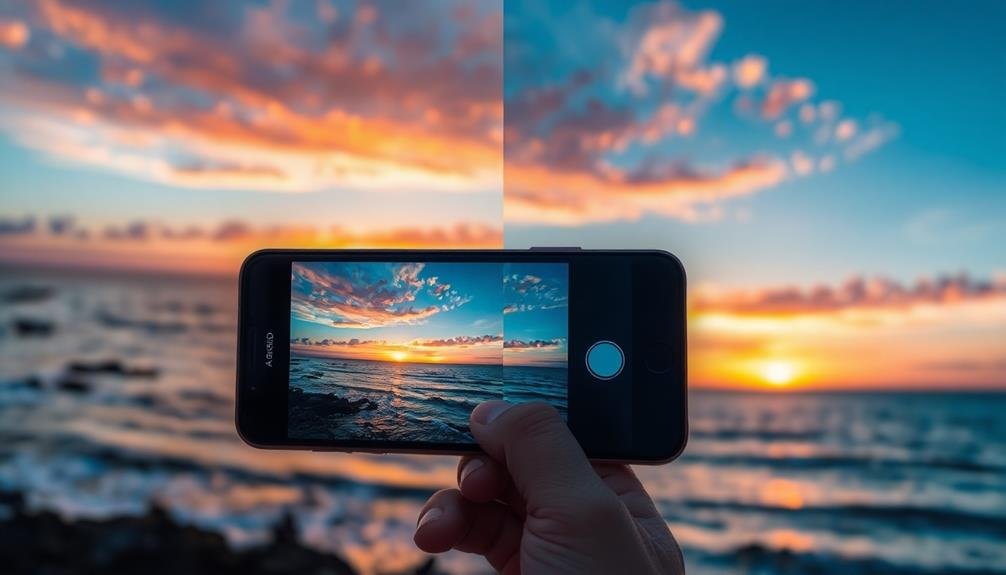
When capturing sunset photos on your mobile device, you'll often encounter challenging lighting conditions.
HDR mode can help you balance the bright sky with darker foreground elements, while exposure compensation allows you to fine-tune the overall brightness of your image.
These tools also enable you to enhance color saturation, bringing out the vibrant hues that make sunset shots so enchanting.
Balancing Light and Dark
Challenges arise when capturing sunset photos due to the stark contrast between bright skies and dark foregrounds. Your mobile device's camera must balance these extremes to create a well-exposed image. To achieve this, you'll need to understand how to manipulate light and shadow.
Start by tapping on different areas of your screen to adjust the focus and exposure. This simple action can dramatically alter the balance of light in your photo. If you tap on the sky, you'll darken the foreground, while tapping on the foreground will brighten it but may overexpose the sky.
Many mobile cameras now offer a "balanced" or "smart" HDR mode, which automatically combines multiple exposures to create a more evenly lit image. Experiment with this feature to see if it enhances your sunset shots.
For more control, use your device's manual mode if available. Adjust the ISO, shutter speed, and aperture to fine-tune the exposure.
Enhancing Color Saturation
Two key techniques can help you enhance color saturation in your sunset photos: HDR and exposure compensation.
HDR, or High Dynamic Range, combines multiple exposures to capture a wider range of colors and tones. When you enable HDR mode on your mobile device, it'll take several shots at different exposures and merge them into a single image, resulting in more vibrant colors and better-defined details in both bright and dark areas.
Exposure compensation allows you to manually adjust the brightness of your image. By slightly underexposing your sunset photo, you can intensify the colors and create a more dramatic effect. Most mobile camera apps offer this feature, typically represented by a +/- icon.
To maximize color saturation in your sunset photos:
- Experiment with HDR mode for balanced exposures
- Use exposure compensation to slightly underexpose the scene
- Try different white balance settings to adjust color temperature
Remember that while these techniques can enhance your sunset photos, it's crucial to maintain a natural look.
Avoid over-saturating your images, as this can lead to unrealistic results. Instead, aim for a balance that captures the beauty of the sunset while preserving the integrity of the scene.
Color Science in Mobile Devices
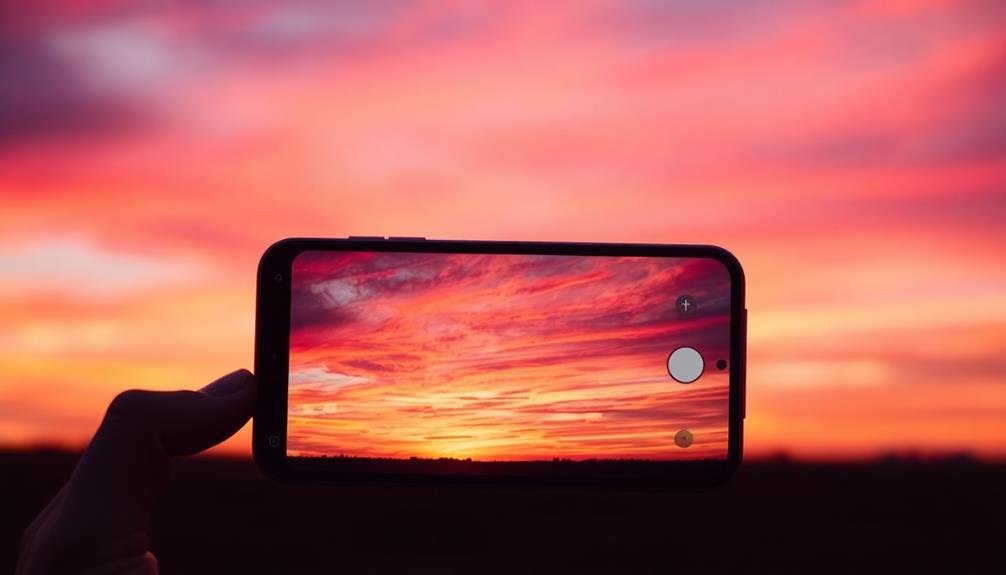
Understanding color science is essential for capturing stunning sunset photos on your mobile device. Modern smartphones employ sophisticated color science algorithms to process and enhance images. These algorithms analyze the scene's color temperature, white balance, and tonal range to produce more accurate and visually appealing results.
Your device's camera sensor captures light in red, green, and blue channels. The color science software then interprets this data, adjusting for the unique characteristics of the sensor and lens. It applies color profiles and gamma curves to guarantee consistent color reproduction across different lighting conditions.
During sunset, the software detects the warm hues and automatically adjusts the white balance to preserve the golden tones. It also enhances the dynamic range, allowing you to capture both the bright sky and darker foreground elements. Advanced noise reduction techniques help maintain image quality in low-light conditions.
Some devices use AI-powered scene recognition to identify sunsets and apply specific color enhancements. This might include boosting saturation in the orange and red spectrum or applying subtle HDR effects to bring out details in clouds and shadows.
AI-Enhanced Image Processing
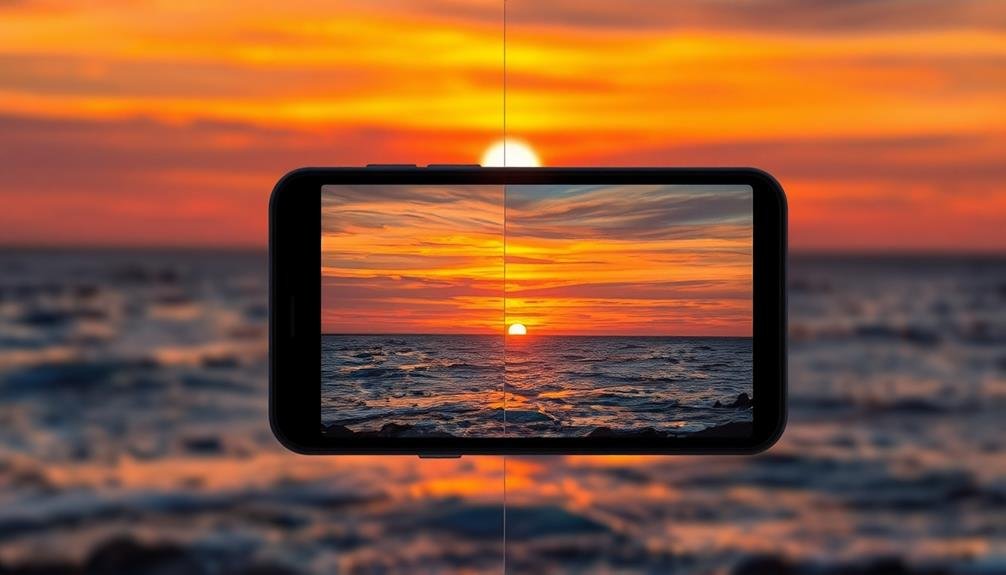
AI-enhanced image processing has revolutionized sunset photography on mobile devices.
You'll find intelligent color enhancement algorithms that automatically adjust hues and saturation to capture the vibrant oranges and purples of a sunset sky.
Automated scene recognition can instantly identify sunset conditions, while real-time exposure adjustment guarantees you don't miss those fleeting golden hour moments.
Intelligent Color Enhancement
Intelligent color enhancement has revolutionized the way we capture sunset photos on our mobile devices. This technology analyzes the image in real-time, identifying key elements like the sky, clouds, and foreground objects. It then adjusts colors, contrast, and saturation to create a more vibrant and visually appealing result.
When you're taking a sunset photo, the intelligent color enhancement system works behind the scenes to:
- Boost warm tones in the sky, enhancing oranges and reds
- Balance exposure between bright and dark areas
- Increase saturation of complementary colors for a more dramatic effect
You'll notice that your sunset photos appear more vivid and true to life, even in challenging lighting conditions. The system adapts to different scenarios, whether you're capturing a beach sunset, a cityscape, or a mountain view.
This technology also helps preserve details in both highlights and shadows, ensuring you don't lose information in the brightest or darkest parts of the image.
As a result, your sunset photos will have improved dynamic range, allowing you to see more details in the clouds and foreground elements.
Automated Scene Recognition
The power of artificial intelligence takes sunset photography to new heights with automated scene recognition. Your mobile device can now instantly identify that you're capturing a sunset scene and adjust camera settings accordingly. This technology analyzes various elements in real-time, such as color temperature, brightness levels, and composition, to optimize your shot.
When you point your camera at a sunset, the AI recognizes key features:
| Feature | Recognition | Adjustment |
|---|---|---|
| Sky | Orange/red hues | Enhance vibrancy |
| Horizon | Silhouettes | Increase contrast |
| Sun | Bright spot | Prevent overexposure |
These intelligent adjustments happen seamlessly, allowing you to focus on framing your perfect shot. The AI can also suggest composition tips, like the rule of thirds, to help you create more visually appealing images.
Moreover, automated scene recognition doesn't just stop at sunsets. It can identify various other scenarios, such as landscapes, portraits, or night scenes, and apply appropriate enhancements. This technology guarantees that even amateur photographers can capture professional-looking images with minimal effort, making the most of your mobile device's camera capabilities.
Real-Time Exposure Adjustment
Harnessing the power of AI, real-time exposure adjustment revolutionizes sunset photography on mobile devices. As you point your camera at the vibrant sky, sophisticated algorithms analyze the scene in milliseconds, making instant adjustments to capture the perfect shot. This technology guarantees that you don't miss fleeting moments of beauty during the rapidly changing light conditions at sunset.
Real-time exposure adjustment offers several key benefits:
- Balanced lighting: It prevents overexposure of bright areas while retaining detail in shadows.
- Dynamic range optimization: It preserves colors and textures across the entire image.
- Automatic HDR: It combines multiple exposures for a more true-to-life representation.
You'll notice that your sunset photos now exhibit richer colors, more defined cloud formations, and better overall clarity. The AI-driven system continuously adapts to changing light levels, allowing you to focus on composition rather than technical settings.
It compensates for limitations in your device's camera sensor, producing results that rival those of high-end DSLRs. With real-time exposure adjustment, you're able to capture stunning sunset images that accurately reflect the breathtaking scenes before you, all with the convenience of your mobile device.
Editing Apps for Sunset Photos
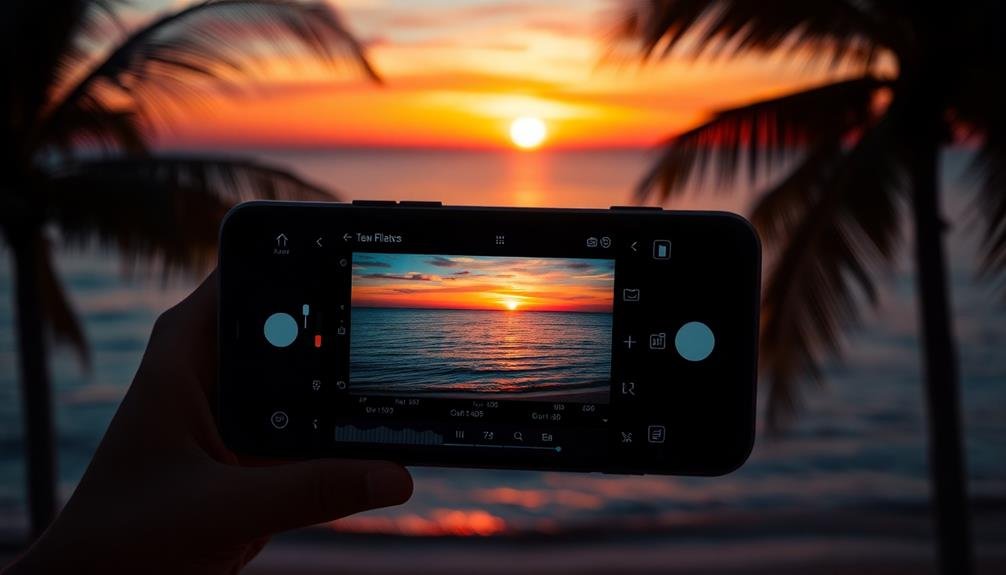
With the right editing apps, you can transform your sunset photos from good to breathtaking. These apps offer a range of tools to enhance colors, adjust exposure, and add creative effects that complement the natural beauty of sunsets.
Popular editing apps like Snapseed, VSCO, and Adobe Lightroom Mobile provide powerful features specifically designed for sunset photography. You'll find preset filters tailored for golden hour shots, as well as advanced tools for fine-tuning highlights, shadows, and color balance.
Here's a comparison of some top editing apps for sunset photos:
| App Name | Key Features | Ease of Use | Cost | Best For |
|---|---|---|---|---|
| Snapseed | Selective edits, HDR | Easy | Free | Quick edits |
| VSCO | Film-like filters | Moderate | Freemium | Artistic looks |
| Lightroom | Professional tools | Advanced | Subscription | Detailed editing |
| Enlight | Creative effects | Moderate | Paid | Unique styles |
| TouchRetouch | Object removal | Easy | Paid | Cleaning up images |
When editing sunset photos, focus on enhancing the warm tones, balancing the exposure between sky and foreground, and bringing out details in the clouds. Don't overdo it – the goal is to enhance the natural beauty of the scene, not create an artificial look.
Frequently Asked Questions
How Do I Find the Best Locations for Capturing Sunset Photos?
To find the best sunset photo locations, you'll want to scout elevated areas with unobstructed western views. Research local spots online, use apps like PhotoPills, and explore your surroundings. Don't forget beaches, hilltops, and urban rooftops for varied compositions.
Can I Take Great Sunset Photos With an Older Smartphone Model?
You can definitely capture stunning sunset photos with an older smartphone. Focus on composition and lighting. Use manual settings if available, clean your lens, and experiment with different angles. Editing apps can enhance your shots post-capture.
What's the Ideal Time to Start Shooting Before the Actual Sunset?
You'll want to start shooting about 30-45 minutes before the actual sunset. This "golden hour" provides soft, warm light that's perfect for photography. Don't forget to experiment with different angles and compositions as the light changes.
How Can I Include Silhouettes or Foreground Elements in Sunset Photos?
To include silhouettes or foreground elements in sunset photos, you'll want to position yourself with objects between you and the setting sun. Adjust your camera's exposure for the bright sky, causing foreground subjects to appear dark and dramatic.
Are There Any Specific Camera Settings for Capturing Sunsets on Smartphones?
You'll want to use your smartphone's HDR mode, lower the exposure, and adjust white balance to "cloudy." Try tapping on the brightest area to focus, and experiment with different angles. Don't forget to stabilize your device.
In Summary
You've learned why sunset photos shine on your mobile device. From advanced camera tech to AI processing, your smartphone's equipped to capture golden hour magic. It's not just about the hardware; it's how your device interprets light and color. Remember, you can enhance your shots with HDR and exposure compensation. Don't forget the power of editing apps to make your sunsets pop. Keep experimenting, and you'll master the art of mobile sunset photography.

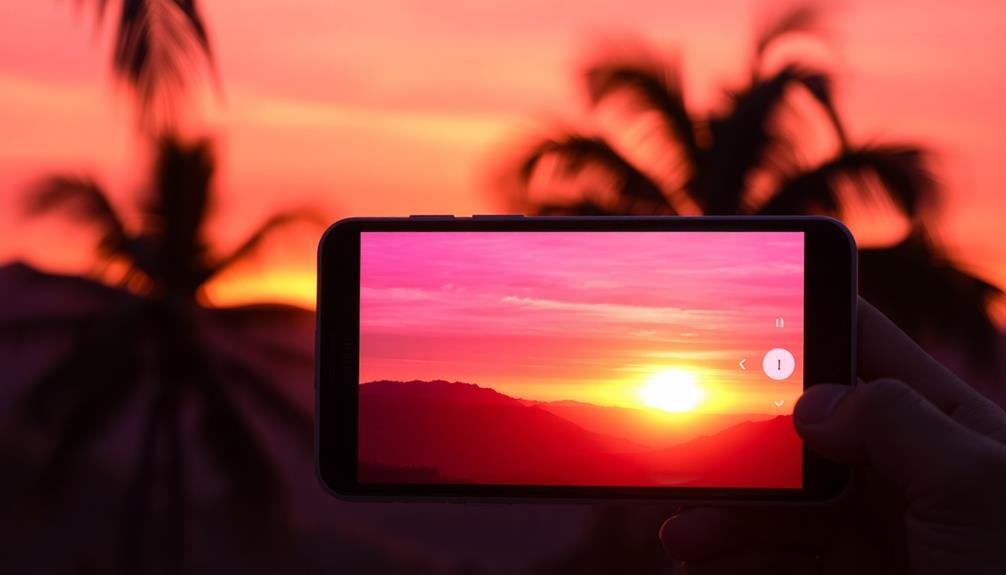



Leave a Reply